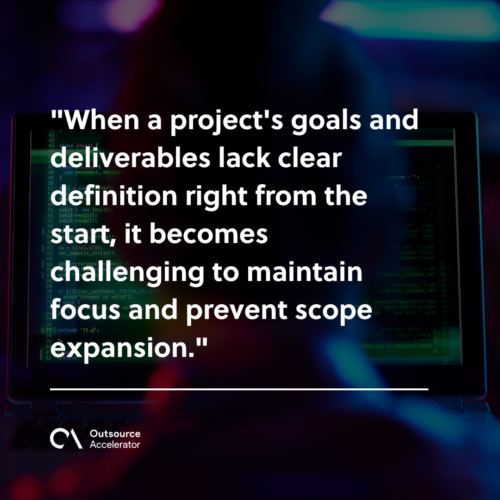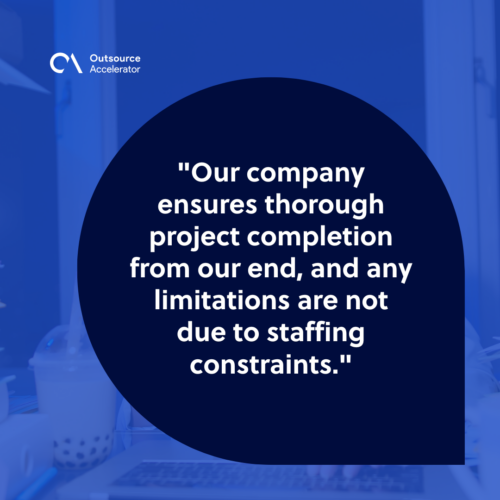How to deal with project creep

Picture this: You start a project, everything’s going smoothly, but suddenly, things begin to wander off course. Changes are made to the project, exceeding the agreed scope.
That’s what we call project creep. Project creep is a hidden problem that can significantly mess up your progress.
In the 457th episode of the Outsource Accelerator Podcast, Rootstack CEO Alejandro Oses defined the challenges of project creep and provided ways on how the company manages it effectively.
What is project creep?
Project creep, or scope creep, refers to the uncontrolled expansion of a project’s scope, often beyond the initial objectives and requirements.
It occurs when additional tasks, features, or changes are introduced without proper evaluation or documentation.
This can increase project complexity, extended timelines, and budget overruns.
Common causes of project creep
Understanding the root causes of project creep is essential for preventing it. Here are some common culprits:
Poorly defined project objectives
One of the primary causes of project creep is poorly defined project objectives.
When a project’s goals and deliverables lack clear definition right from the start, it becomes challenging to maintain focus and prevent scope expansion.

Alejandro discusses these issues, which he says are often witnessed when projects lack defined objectives.
“Many projects in the seniority industry fail due to inadequate discovery. Having a well-defined discovery phase is crucial, similar to planning a building.”
Stakeholder demands and scope changes
Stakeholder demands and scope changes can also contribute to project creep.
As project stakeholders request modifications or additional features, it’s crucial to have a structured process for evaluating these requests and their impact on the project’s scope.
Inadequate discovery phase and planning management
Insufficient attention to the discovery phase and effective planning management can set the stage for project creep.
When a project lacks a well-structured plan and a robust scope management process, the ability to track and control changes effectively is compromised.
Alejandro highlights the potential consequences of neglecting a proper discovery phase and planning, which include:
- Increased costs
- Delays
- Misconceptions about deliverables
He emphasizes that, like in building construction, many factors must be considered after a comprehensive discovery phase, such as budgeting and time estimates.
Strategies for preventing project creep
To mitigate project creep and ensure the successful completion of your projects, consider implementing the following strategies:
Hire a project manager
The Rootstack CEO recommends hiring a dedicated project manager to oversee your projects.
He emphasizes the importance of a project manager’s ability to explain how a project is progressing, stating, “A very good project manager can explain how a project works”
Further, Alejandro highlights that a skilled project manager should address the technical aspects and be attentive to budget considerations.
He explains, “[A] project manager should know not only the technical side but also the budget inside, how it’s evolving.”
Comprehensive project planning
Comprehensive project planning is essential to prevent project creep.
Create a detailed project plan outlining the required objectives, deliverables, timelines, and resources. Regularly review and update the plan as necessary.
Alejandro elaborates on their company’s approach to comprehensive project planning, stating, “Our company ensures thorough project completion from our end, and any limitations are not due to staffing constraints.”

He emphasizes that they prioritize a thorough discovery phase in their agile projects to ensure that they don’t build something completely wrong.
Scope management
Implement a robust scope management process to evaluate and document all proposed changes to the project scope.
Ensure scope changes align with the project’s objectives and are approved through a formal change request process.
Stakeholder engagement
Engage stakeholders throughout the project to understand their needs and expectations.
Clear communication with stakeholders can help identify potential scope changes early and address them proactively.
Alejandro emphasizes the benefits of this approach, explaining that Rootstack allows their clients to be creative, have flexibility, and make transformations as needed during the project.
He said, “We let our clients do the type of things. They can be creative. They can have things, they can evolve, they can transform.”
Project monitoring and control
Establish a system for continuous project monitoring and control. Regularly track progress, budgets, and timelines. Identify deviations from the plan and take corrective action promptly to prevent scope creep.
Moreover, Alejandro mentions that their billing method aligns with this agile approach.
Risk assessment and mitigation
Conduct a thorough risk assessment at the beginning of the project. Identify potential risks that could lead to scope changes and develop mitigation plans. Proactively addressing risks can prevent project creep.
Prevent project creep to ensure that your projects stay on track
Alejandro sees similarities between achieving career success and delivering excellent products or services.
He emphasizes that project success requires effective time management, delivering top-notch quality, and assembling the right team.
He says, “Success basically [] having quality delivered. So, having good project management, the right team, and qualifications are crucial.”
Further, project creep can pose significant challenges to project success, but it can be effectively managed and prevented with the right strategies and practices.
By understanding its causes and implementing proactive measures, you can ensure that your projects stay on track and meet their objectives.







 Independent
Independent




